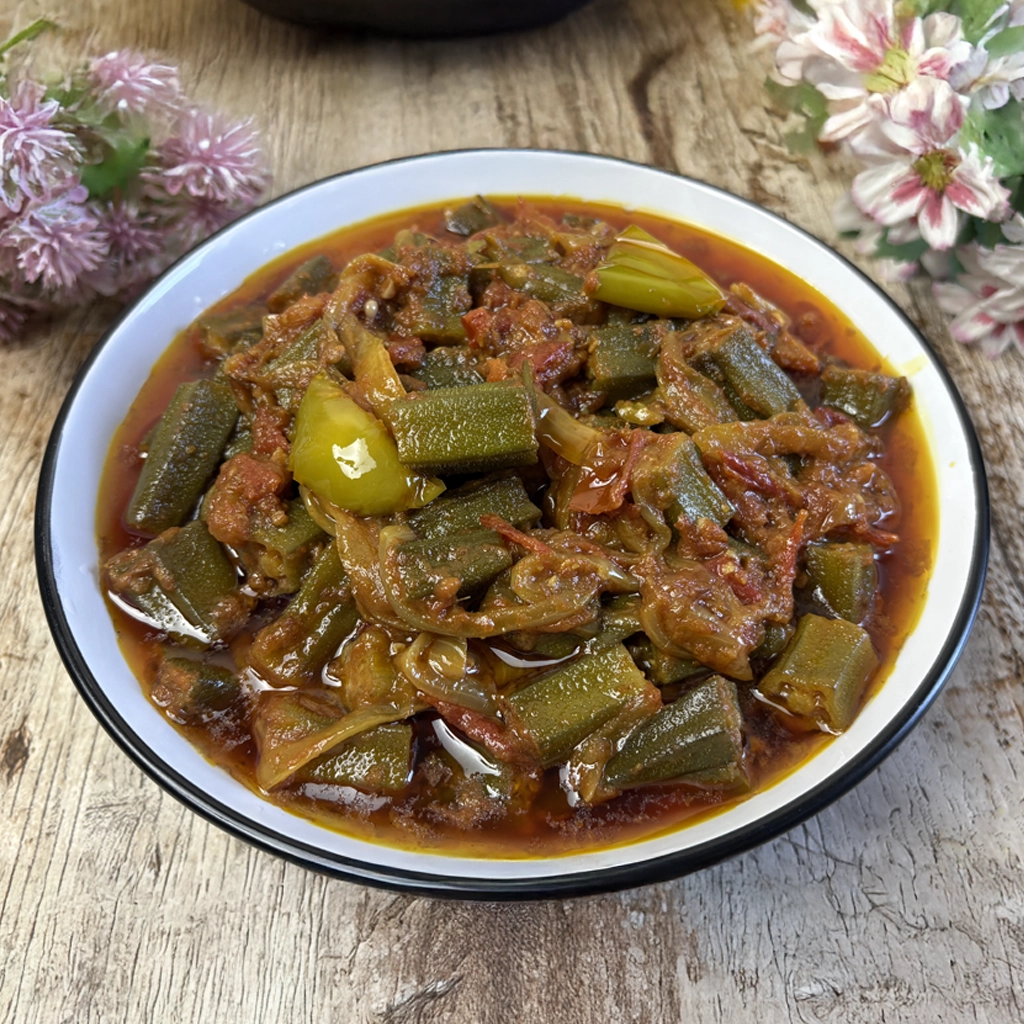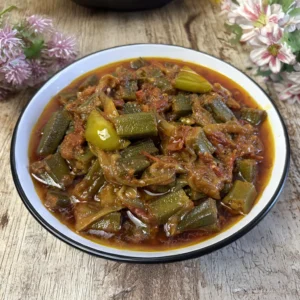
I made one of my favourite recipes today—bhindi masala. It’s something I’ve grown up eating, and every time I cook it, it brings back a warm sense of comfort. There’s something about the simplicity of this recipe that makes it feel special every time.
I focused on keeping everything straightforward, from the preparation to the final result. Bhindi has a way of soaking up flavour while still holding on to its texture, and that balance is what I love most about making this. It’s one of those recipes I always come back to.
If you’ve been craving something homely and full of flavour, I hope this bhindi masala speaks to you the same way it does to me. Let me know what you think after you’ve tried it—I’d love to hear your thoughts.
Okra (Bhindi) – This green, elongated vegetable is renowned for its unique texture and flavor. Often used in Indian cuisine, it is high in dietary fiber, vitamins, and minerals.
The slimy texture when cooked can be off-putting to some, but it contributes to the dish’s richness and helps to bind ingredients together, enhancing the overall mouthfeel.
Oil – A crucial element in cooking that facilitates heat transfer and enhances flavor. The choice of oil can vary, but options like vegetable oil, mustard oil, or ghee can impart different taste profiles. Oil helps to sauté ingredients, develop flavors, and achieve the desired consistency in the dish.
Cumin Seeds – These small, brown seeds are essential for adding earthiness and warmth to dishes. Cumin has a slightly nutty, peppery flavor and is often toasted before use to release its aromatic oils, intensifying its flavor. It’s a common spice in Indian cooking and enhances the overall depth of flavor in this recipe.
Ginger Paste – Fresh ginger is ground into a paste to provide warmth and a zesty flavor. It adds a unique bite and contributes beneficial properties, including anti-inflammatory benefits. Ginger adds brightness to the dish and balances the other spices and ingredients.
Garlic Paste – Made from grinding fresh garlic cloves, this paste brings a strong, pungent flavor that complements the other ingredients. Garlic is known for its aromatic qualities and health benefits, including immune-boosting properties. It enhances the aroma of the dish and deepens its flavor profile.
Onions – Chopped or sliced onions serve as a flavorful base for the dish. They add sweetness and depth, especially when sautéed to golden perfection. Onions caramelize and contribute a rich aroma, forming a key component that harmonizes the other flavors in the recipe.
Tomatoes – Fresh or canned tomatoes add acidity and moisture, balancing the richness of the other ingredients. They contribute to the overall color and provide a slight sweetness, enhancing the dish’s taste. Cooked down, tomatoes thicken the mixture and create a cohesive sauce.
Bullet Chilli – Known for their spiciness, bullet chillies add heat and a distinct flavor to the dish. These small, green chilies can be used whole or chopped, allowing for a customizable level of spice. Their presence elevates the dish and complements the other ingredients beautifully.
Turmeric Powder – This bright yellow spice not only adds a warm color but also imparts a slightly earthy flavor. Turmeric is celebrated for its health benefits, particularly its anti-inflammatory properties. It plays a vital role in creating the characteristic color and taste profile of many Indian dishes.
Salt – Essential for enhancing the flavors of all ingredients, salt brings balance to the dish. It amplifies sweetness, counters bitterness, and ensures that the spices come together harmoniously. Proper seasoning is key to achieving the desired flavor in any recipe.
Chilli Powder – A blend of ground dried chillies, this spice adds heat and a rich depth of flavor. The type and amount of chilli powder used can control the spiciness of the dish, providing warmth without overpowering the other ingredients. It is a staple in Indian cooking, contributing vibrant color and flavor.
Cumin Powder – Ground from roasted cumin seeds, this spice offers a more concentrated flavor than whole seeds. Cumin powder adds warmth and a distinct earthy taste, enhancing the complexity of the dish. It’s often used alongside other spices to create a balanced flavor profile.
Bhindi Masala is a delicious and versatile dish that can be enjoyed in various ways or adapted to suit different tastes. The base ingredients you have—okra, spices, and aromatics—allow for numerous serving suggestions and variations to elevate your culinary experience.
To start, Bhindi Masala pairs wonderfully with a variety of Indian breads. You can serve it alongside soft naan, crispy parathas, or even traditional chapati.
This combination will make for a satisfying meal, as the breads can help scoop up the flavorful bhindi. If you prefer rice, consider serving it with basmati rice or jeera rice, which complements the spices nicely.
For a complete meal, add a side of cooling raita. A simple cucumber or mint raita made with yogurt can balance the heat from the spices in the Bhindi Masala and provide a refreshing contrast.
A salad of mixed vegetables—like sliced cucumbers, tomatoes, and onions dressed with lemon juice and spices—can also add a fresh element to your meal.
If you want to enhance the flavors of Bhindi Masala, consider adding extra ingredients. For a richer taste, you can include some diced potatoes or bell peppers. These vegetables will absorb the spices and add different textures to the dish.
Another option is to incorporate other greens like spinach or fenugreek leaves, which can add nutrition and a unique flavor profile.
For a slightly tangy twist, add a splash of lemon juice or a tablespoon of tamarind paste towards the end of cooking. This will brighten the dish and offer an interesting contrast to the earthy flavors of the okra.
Should you want to give your Bhindi Masala a more robust flavor, consider using roasted spices. Dry roast cumin seeds and coriander seeds, then crush them into a powder before adding them to the dish. This technique brings out the essential oils in the spices, developing a deeper aroma and taste.
If you love a bit of creaminess, stir in some coconut milk towards the end of cooking. This transforms the dish and gives it a delightful, creamy texture that complements the spices beautifully. Alternatively, adding a few tablespoons of yogurt can provide a similar effect while keeping it tangy.
If you want to elevate the aesthetic of your Bhindi Masala, consider garnishing it with freshly chopped coriander or a sprinkle of fried onions.
This not only adds visual appeal but also enhances the flavor profile. For those who enjoy a touch of crunch, toasting some cashews or peanuts and tossing them on top can add an enjoyable texture.
Incorporating different types of heat can also change up the dish. If bullet chilies are too spicy for your taste, use milder green chilies or even swap them for a pinch of red pepper flakes for those who desire a milder kick.
Alternatively, if bold spice is what you seek, add more chili powder or even a pinch of garam masala for an extra punch of flavor.
Regardless of how you choose to serve or modify this Bhindi Masala recipe, the fundamental goal is to explore and enjoy the rich Indian flavors. Mixing and matching various accompaniments and ingredients can lead to a new family favorite or a delightful surprise at your next gathering.
Bhindi Masala is a popular Indian dish made with okra (bhindi) sautéed with a variety of spices, onions, and tomatoes. It is known for its rich flavor and is often served as a side dish with roti, rice, or parathas.
Before cooking, wash the okra thoroughly and dry it completely. It’s important to dry it to prevent sliminess during cooking. Cut off the tops and tails, then slice the okra into pieces, usually about an inch long.
Yes, you can use frozen okra, but fresh okra is preferred for its texture. If using frozen, ensure it is thawed and drained to minimize moisture.
To reduce the sliminess of bhindi, ensure that it is well dried after washing, cook it on high heat, and avoid overcooking. Adding a bit of acid, like lemon juice or tomatoes, can help reduce slime as well.
Variations may include adding different vegetables, such as potatoes or bell peppers, incorporating coconut or yogurt, or changing the spice mix. Each region in India may have its own twist on the dish.
Yes, you can prepare Bhindi Masala ahead of time. It can be stored in an airtight container in the refrigerator for up to 2-3 days. Reheat it in a pan before serving.
Bhindi Masala pairs well with various dishes, including roti, naan, rice, and dal. It makes for a fantastic side dish in a traditional Indian meal.
Yes, Bhindi Masala is a vegetarian and vegan dish as it contains no animal products. It is a healthy option packed with nutrients.
Here are some more recipes for you to enjoy! If you my recipes don’t forget to rate and leave a comment.
If you have any recipe suggestions, please do not hesitate to ask me. A great way to stay in contact with me is through Instagram, Facebook, Twitter and YouTube. Don’t forget to tag me @CookwithNabeela in your recipe photos!

Subscribe now to receive my latest recipes directly in your inbox. Stay up-to-date and never miss out!

I love to cook! I want to share with you my favourite, delicious family-friendly recipes. I want to inspire you to create fantastic food for your family every day.
Add your first comment to this post